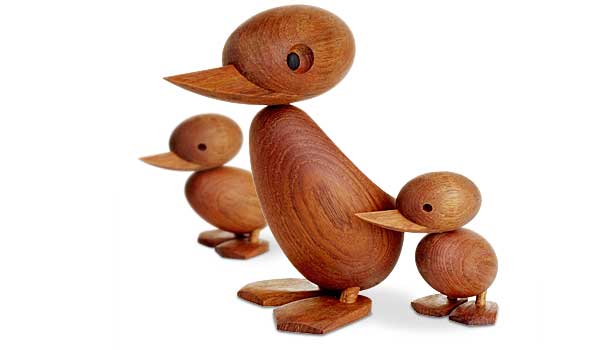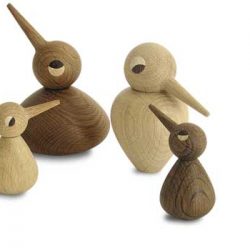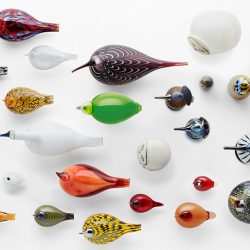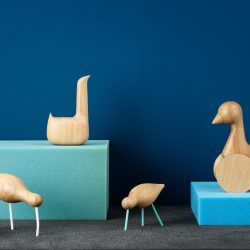Birds in the Nordic design
10.16.2017Birds: the freedom of Nordic design, by Ásdís Ólafsdóttir
In 1959, a family of ducks waddling across a busy road in Copenhagen brought the traffic to a halt. As the news hit the papers, the adventure of these ducks struck a chord in the Danes. Designer and architect Hans Bølling (born in 1931) was inspired by the story and created his famous duck and duckling family out of wood called Ducks. Fashioned by hand from oiled teakwood, these adorable creatures have delighted several generations of Danes and now find themselves getting a facelift.
The bird motif is traditionally used to embellish embroidery and textiles in Nordic countries. They can be found on ceramics and porcelain, but wooden ones only started to appear at tail end of the Fifties. In keeping with the tradition of Danish cabinetmakers, these items were often a secondary activity with a playful twist. As interest in them grew, design companies such as Architectmade and Lucie Kaas updated them, thereby helping to promote the names of their designers. The first to devote himself to designing wooden toys in the Thirties was Kay Bojesen (1886-1958). His Songbird dates back to 1950 but was not put into production and it was his teak and limba Monkey in 1951 that make him famous. Several of his bird designs are currently being produced by the Kay Bojesen Company.
Sparrows and Pelicans by Gunnar Flørning (1932-2014), designed at the end of the Fifties, were still quite « realistic » in appearance just like the Ducks by Hans Bølling. The family of Birds by Kristian Vedel (1923-2003), designed in 1959, are far more stylised. The round head of the bird is simply placed on an oval body and the tilt of the head creates a wide variety of expressions. Discus, designed in 1961 by Hans Bølling, is a kind of parrot made from pine that is partially painted in vivid colours. These designers often used oak and ash to work with, sometimes combined with exotic wood. The surface and finish of the wood add a tactile element to the object that makes you want to pick it up.
Finnish designer Oiva Toikka (born in 1931) sets himself apart from his Danish colleagues by using glass as his favourite material to work with. His most well known series is his Birds Collection, created in 1972 for glass company Iittala. Over a period of 45 years he has designed over four hundred birds as varied as those that can be found in nature. Each bird is blown by a master glassmaker thereby fusing technical prowess with artistic creativity. Toikka is different to the minimalist trend in Nordic design in the sense that he is more outlandish, colourful and experimental. His birds, the annual production of which is awaited with bated breath, are now the targets of collections in the four corners of the world.
In recent years the tradition of wooden birds has found new life among a new generation of young Nordic designers. Norwegian Andreas Engesvik designed his Owls in 2011 (launched by Menu) and fellow countryman Lars Beller Fjetland created his Turned series in 2013. Comprising of a kiwi, an owl, a penguin, a pigeon and a sparrow, this collection is made from recycled mahogany, oak, ash, walnut and maple. Icelandic designer Sigurjón Pálsson launched his Shorebirds inspired by Icelandic migrating birds. Produced since 2014 by Normann Copenhagen, they are made from oak and feature colourful feet and beaks.
European designers have also jumped on this trend, such as German designer Jan Christian Delfs with his minimalist Little Bird collection in natural oak or painted oak for Normann Copenhagen. Ronan and Erwan Bouroullec designed L’Oiseau (the Bird) in 2011, an avian figure of an almost archaic simplicity recalling the purity of Nordic objects. Produced by Vitra, L’Oiseau is made from maplewood or ceramic in colours close to those of the Fifties. These « new versions » focus once more on woodworking techniques and collections of different sized objects such as those created by Danish masters from the post-war period. These figures can also be collected and grouped together as desired.
The bird symbolises freedom, grace and beauty. These Nordic objects are the gateway to this imaginary world yet their solid bodies, made of wood or glass, allow us to feel, touch and hold them in the palms of our hands. These birds create a link between nature, traditional craftsmanship and home interiors that create a feeling of well-being.
Ásdís Ólafsdóttir is an historian of Design and Director of Maison Louis Carré.
- Kristian Vedel, Birds (éd. Architectmade)
- Oiva Toikka, Birds Collection (éd. Iittala)
- Sigurjón Pálsson, Shorebirds (éd. Normann Copenhagen)





